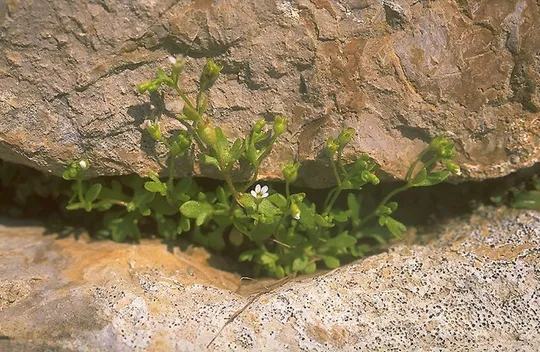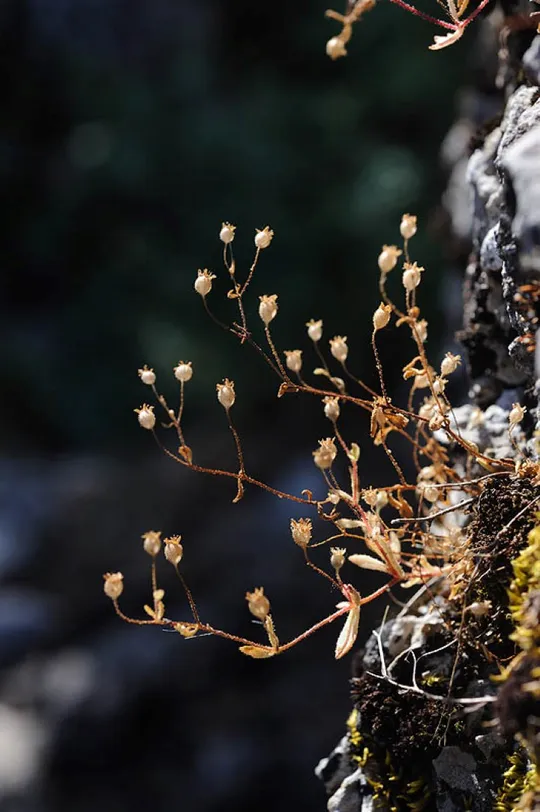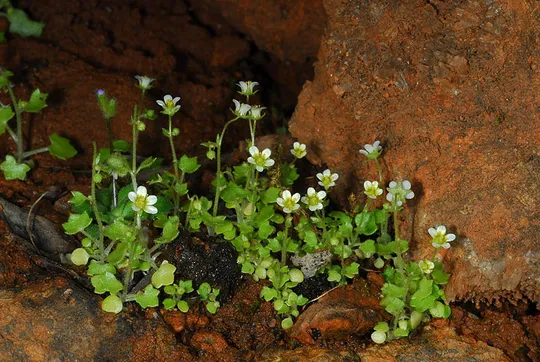Rue-leaved Saxifrage, Rueleaf Saxifrage
Saxifraga tridactylites



Saxifraga tridactylites grows only in the eastern Upper Galilee: most of the sites are located in the drainage basin of the Dishon Stream, from Wadi Aviv in the west to Sde Eli'ezer in the east. Other sites in the same surroundings are located on the Mount Evyatar cliff, in Wadi Hatsor and Wadi Rosh Pina (Mount Cna'an). The species was found for the first time on Mount Hermon on the Namneman Ridge in 1984 and was not known previously from Israel. On the Hermon, S.tridactylites is currently found in most of the ravines that descend from the peak of the mountain to the west – Wadi Ar'ar, Wadi Si'on, Wadi Govta and Wadi Hatsor. S. tridactylites was also collected from the Banias.
Very shallow soil pockets on sunny well-lit open areas on moist, north-facing rocks and cliffs. Saxifraga tridactylites also grows on the edges of open woodland. On the Hermon the plant grows on shaded limestone cliffs. Common in Europe on fences, walls and on side paths.
The genus Saxifraga has about 350 species found in the Arctic and northern regions of the Old and New World. Most varieties in the genus are perennial, and grow as rosette cushion plants on rocks and cliffs. Only a few of the species growing in the southern part of Saxifraga's range, particularly in the Mediterranean Basin are annual species. Two closely related annual species grow in Israel, which is located on the southern boundary of Saxifraga's distribution area. Their geographical distribution however, is allopatric: Whereas S. hederacea grows in the Carmel and in the central and western Galilee, S. tridactylites is limited to the eastern Galilee and Mount Hermon. S. tridactylites is similar to S. hederacea, but differs from it in its erect stems and its elongated, narrow leaves, unlike S. hederacea whose broad large leaves are borne on distinct petioles. Also S. tridactylites has sticky glandular parts, and a partially inferior ovary that gives the calyx a unique swollen shape, unlike S. hederacea that has a superior ovary enclosed by the calyx.
• Saxifraga tridactylites grows at a few sites, with a small number of plants in each one. Most of the sites are located within a limited area of about 30 square meters, 1-3 km apart. The maximal distance between two sites is about 12 km.
• The plant grows in Israel at only 10 sites, all located in one geographical area, adjacent to each other.
• Most sites are included in the Dishon Stream Nature Reserve. The sites on Mount Tsvi, Mount Cana'an and in a section of Sde Eli'ezer (three populations) are not in nature reserves.
• The species is not prominent in the field and is not threatened by picking. Because it grows mostly on cliffs and rocks there is no danger of agricultural and urban development.
• The area is intensely grazed by cows. Grazing pressure should be controlled to ensure that grazing will not spread to Saxifraga’s habitat.
The rare species survey conducted in 1991 should be repeated and extended to the area between the Dishon Stream and Wadi Rosh Pina. Two populations should be monitored: in the Dishon Stream bed (west of where it meets Wadi Aviv), and on the Mount Evyatar cliff.
Saxifraga tridactylites grows throughout Europe and most of the Mediterranean countries and in North Africa. In the Middle East, it grows in Turkey, western Syria, and northern Iraq, western and southern Iran and in the Caucasus. Its distribution continues eastward to central and eastern Russia.
Saxifraga tridactylites is a miniscule annual plant, categorized as "red" because in Israel it grows in only a few sites, in a limited area of one region. Is populations extend over a very small area and are not far apart. The sites are not threatened by development but suffer from intense cattle grazing pressure. S. tridactylites is a peripheral plant, for which the Wadi Dishon area is the southern edge of its global distribution.
כהן, ע. ושמידע, א. 1987. "צמחי החודש". טבע וארץ כ"ט,7, 16-18.
Current Occupancy Map
| 1000 squre meter pixel | 5000 squre meter pixel | 10000 squre meter pixel | |
|---|---|---|---|
| number of observations | 0 | 0 | 0 |
| in total pixels | 0 | 0 | 0 |
| Family | Saxifragaceae |
| Classification | On the extremely rare species list |
| Ecosystem | Mediterranean |
| Chorotype | Euro – Siberian and Mediterranean |
| Conservation Site | Dishon Stream |
| Rarity |
1
3
6
|
|---|---|
| Vulnerability |
0
0
4
|
| Attractiveness |
0
0
4
|
| Endemism |
0
0
4
|
| Red number |
1
2.1
10
|
| Peripherality | N |
| IUCN category | DD EW EX LC CR EN VU NT |
| Threat Definition according to the red book | Least concern |
 Based on:
Based on:






